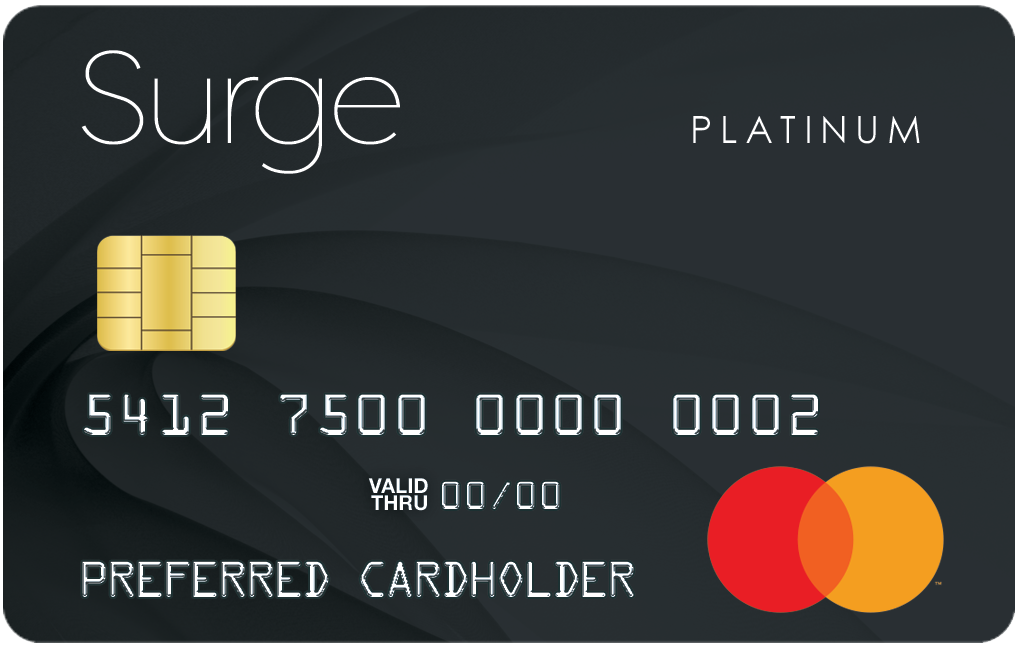Surge Credit Card Review: A Pricey Way to Build Credit
The Bottom Line
1.8
Even if you have poor credit, there's little upside to this card. Look instead to secured credit cards, keeping in mind that the deposit you'll owe is refundable — unlike the fees here.


Rates, fees and offers
Rates, fees and offers
Annual fee
$75-$125
Rewards rate
N/A
Bonus offer
N/A
Intro APR
See Continental Finance's website for Details*
Ongoing APR
APR: 35.90% Fixed APR
Foreign transaction fee
3% of each transaction in U.S. dollars
More details from Continental Finance
More details from Continental Finance
- Up to $1,000 Initial Credit Limit.
- See if you Pre-Qualify with No Impact to your Credit Score.
- Less than perfect credit? We understand. The Surge Mastercard is ideal for people looking to rebuild their credit.
- Unsecured credit card requires No Security Deposit.
- Perfect card for everyday purchases and unexpected expenses.
- Monthly reporting to the three major credit bureaus.
- Use your card everywhere Mastercard is accepted at millions of locations.
- Enjoy peace of mind with Mastercard Zero Liability Protection for unauthorized purchases (subject to Mastercard guidelines).
Detailed Review
The Surge® Platinum Mastercard®, issued by Celtic Bank and serviced by Continental Finance, offers some qualities that may appeal to those seeking a second chance at building credit. But its fees far outweigh its benefits.
There's no security deposit required, and it does offer a pre-qualification process. It also reports payments to all three major credit bureaus, which can help your credit if you pay your monthly bill on time.
But even among credit cards for bad credit (FICO scores of 629 or lower), the Surge® Platinum Mastercard® is an expensive option that is likely not sustainable over the long term. You stand to save money by paying a security deposit on a secured credit card, as you can get that money back with a good payment history. With the Surge® Platinum Mastercard®, you’ll never get back the ongoing annual fee (up to $125) or the potential monthly maintenance fees (up to $12.50).
That’s a cost of up to $275 annually in fees alone, plus more if you pay interest charges.
There are plenty of better (and much less expensive) credit cards for bad credit.
Surge® Platinum Mastercard®: Basics
Card type: Credit builder; bad credit.
Annual fee: $75-$125.
Monthly maintenance fee: For credit limit of $300 or $500, the monthly fee is $0 for the first year, then $150 thereafter (billed $12.50 per month).
Sign-up bonus: N/A.
Rewards: None.
APR: The ongoing APR is 35.90% Fixed APR.
Late fee: Up to $41.
Foreign transaction fee: 3% of each transaction in U.S. dollars.
Benefits and Perks
Payments reported to major credit bureaus
The Surge® Platinum Mastercard® reports payments to all three major credit bureaus (TransUnion, Equifax and Experian), companies that collect the information used to calculate your credit scores. Reporting payments to all three credit bureaus is a must-have feature if your goal is to build credit, but it’s not a standout feature. Many other credit cards for bad credit also report payments to these companies, so this feature alone shouldn’t be the only factor that sways your decision.
Drawbacks and Considerations
Expensive fees
The expensive fees on the Surge® Platinum Mastercard® make it difficult to justify keeping your account open over time, which is ideal if you want to build good credit. As is the case with any credit card, it can hurt your credit scores if you close your account.
But consider what it'll cost you to not close out this card:
Annual fee: $75-$125.
Monthly maintenance fee: $0 the first year, then $0 to $12.50 per month (up to $150 annually).
Late payment fee: Up to $41.
For lower fees, instead consider the $0-annual-fee Capital One Platinum Secured Credit Card. It requires an upfront security deposit, but unlike the various fees on the Surge® Platinum Mastercard®, that deposit is refundable. And there are different minimum deposit requirements — $49, $99 or $200 — depending on your eligibility. Regardless of which one you qualify for, you’ll get a minimum $200 credit limit. There's also a potential upgrade path to better Capital One products once your credit improves.
No path to better options
Even if you're able to use the Surge® Platinum Mastercard® to shore up your credit, there is no outlined path to upgrade to a better credit card when you're ready. For a reliable path to upgrade, instead consider the $0-annual-fee Discover it® Secured Credit Card. It has a minimum $200 security deposit requirement, but again that money is refundable. The card also offers rewards and a welcome bonus, which may help make up some of the cost of the security deposit. The Discover it® Secured Credit Card touts that it reviews accounts after seven months to determine your eligibility to upgrade to a traditional unsecured credit card, in which case you'll get your deposit back.
A high APR
The Surge® Platinum Mastercard® charges a high interest rate. (The ongoing APR is 35.90% Fixed APR.) While that’s not uncommon among credit cards for those with less-than-ideal credit, there are options like the Chime Card™ that skip interest charges and fees altogether. It doesn’t function like a traditional secured credit card. You can choose your own security deposit, but you’ll have to open a Chime Checking Account first. The amount moved from the spending account to the Credit Builder secured account determines your credit limit. Keep in mind that the Chime Card™ also doesn’t have a path to upgrade to a better option, but it is a more accessible and less costly option than the Surge® Platinum Mastercard®.
See more from Chime®
Chime says the following:
The Chime Card™ is issued by The Bancorp Bank, N.A. or Stride Bank, N.A., pursuant to a license from Visa U.S.A. Inc. and may be used everywhere Visa credit cards are accepted. Please see the back of your card for its issuing bank.
Based on a representative study conducted by Experian® in January 2024, members who made their first purchase with Credit Builder, an earlier version of the Chime Card™, between June 2022 and October 2022 observed an average FICO® Score 8 increase of 30 points after approximately 8 months. A credit score improvement is not guaranteed. On-time payment history can have a positive impact on your credit score. Late payment may negatively impact your credit score. Activity on other credit accounts may also impact your score.
On-time payment history may have a positive impact on your credit score. Late payment may negatively impact your credit score. Chime will report your activities to Transunion®, Experian®, and Equifax®. Impact on your credit may vary, as Credit scores are independently determined by credit bureaus based on a number of factors including the financial decisions you make with other financial services organizations.
Money added to the Chime Card™ will be held in a secured deposit account as collateral for your Chime Card™, and you can spend up to this amount. You can use money deposited in your Secured Deposit Account to pay off your charges at the end of every month.
Out-of-network ATM withdrawal and over the counter advance fees may apply.
SpotMe® on Credit is an optional, no interest / no fee overdraft line of credit tied to the Secured Deposit Account available to qualifying members with an active Chime Card Account. To qualify for the SpotMe on Chime Card service, you must receive $200 or more in qualifying direct deposits to your Chime® Checking Account each month and have activated your physical secured Chime Visa® Credit Card or Chime Visa® Debit Card. Qualifying members will be allowed to overdraw their Secured Deposit Account up to $20, but may later be eligible for a higher limit of up to $200 or more based on Chime account history, direct deposit frequency and amount, spending activity and other risk-based factors. The SpotMe on Chime Card Limit will be displayed within the Chime mobile app and is subject to change at any time, at Chime’s or its banking partners’ discretion. Although Chime does not charge any overdraft fees for SpotMe on Chime Card, there may be out-of-network or third-party fees associated with ATM transactions and fees associated with OTC cash withdrawals. SpotMe on Chime Card won’t cover non-card transactions. SpotMe on Chime Card Terms and Conditions.
With a qualifying direct deposit, earn 1.5% cash back on eligible secured Chime Visa® Credit Card purchases.
No rewards
Rewards aren’t necessarily a priority when your goal is to build credit, but some cards in this class offer them. The $0-annual-fee Capital One Quicksilver Secured Cash Rewards Credit Card, for instance, earns 1.5% cash back on purchases, plus 5% back on hotels, vacation rentals and rental cars booked through Capital One Travel. It also offers an automatic credit limit review after six months and an opportunity to graduate to an unsecured version of the same card if you're eligible. It requires a minimum $200 security deposit, but with a good payment history you can eventually get that money back once you upgrade to the unsecured option or close the account. The rewards can also return some value while your deposit is tied up.
How To Decide If It's Right For You
The Surge® Platinum Mastercard® has very few pros compared with its long list of cons. With hefty ongoing fees, you’re better off exploring secured credit card options that have lower long-term costs. Secured credit cards can offer a chance to get your deposit back, but you’ll never get back the annual fee and monthly maintenance fee on the Surge® Platinum Mastercard®.
Looking For Something Else?
Methodology
NerdWallet reviews credit cards with an eye toward both the quantitative and qualitative features of a card. Quantitative features are those that boil down to dollars and cents, such as fees, interest rates, rewards (including earning rates and redemption values) and the cash value of benefits and perks. Qualitative factors are those that affect how easy or difficult it is for a typical cardholder to get good value from the card. They include such things as the ease of application, simplicity of the rewards structure, the likelihood of using certain features, and whether a card is well-suited to everyday use or is best reserved for specific purchases. Our star ratings serve as a general gauge of how each card compares with others in its class, but star ratings are intended to be just one consideration when a consumer is choosing a credit card. Learn how NerdWallet rates credit cards.
About the author

Melissa Lambarena
Senior Writer & Content Strategist